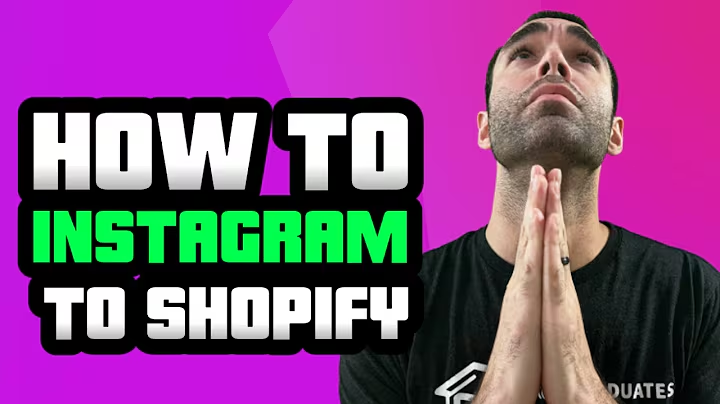Maximize Your Shopify Store's Revenue with Google Ads
Table of Contents
- Introduction
- Setting up a Google Merchant Center Account
- Linking Google Merchant Center and Shopify
- Setting up a Google Ads Account
- Optimizing Product Listings in Shopify
- Creating the First Google Ads Campaign
- Adding Tracking Tags with Simprosis
- Adding Competitor URLs for Audience Targeting
- Setting the Budget for the Google Ads Campaign
- Optimizing Product Categories in Simprosis
- Conclusion
Introduction
In this article, we will guide you through the step-by-step process of setting up Google Ads for your Shopify store. Whether you're a beginner or have been running a Shopify store for a while, this tutorial will provide you with the knowledge and tools to optimize your Google Ads and maximize revenue. We will cover everything from setting up a Google Merchant Center account to optimizing your product listings and creating your first Google Ads campaign. By following these strategies and techniques, you can effectively drive traffic to your store and increase your sales. Let's get started!
1. Setting up a Google Merchant Center Account
To begin, we will show you how to set up a Google Merchant Center account. This step is essential for linking your Shopify store to Google Ads and showcasing your products effectively. We will guide you through the process of signing up for a free account and connecting it to your Google Ads. We will also discuss the importance of manually setting up the Merchant Center account to optimize your product listings further.
2. Linking Google Merchant Center and Shopify
Once you have set up your Google Merchant Center account, the next step is to link it with your Shopify store. We will provide you with a step-by-step guide on how to connect the two platforms efficiently. By linking your accounts, you can seamlessly sync your products to Google Merchant Center and streamline the management of your Google Ads campaigns.
3. Setting up a Google Ads Account
After linking your Google Merchant Center and Shopify accounts, we will show you how to set up your Google Ads account. This process involves creating your first Google Ads campaign and optimizing it for maximum profitability. We will guide you through the necessary steps, including choosing the right campaign type, selecting your target audience, and determining your budget.
4. Optimizing Product Listings in Shopify
To ensure effective advertising on Google Ads, it is crucial to optimize your product listings in Shopify. We will provide you with strategies and best practices to optimize your titles, descriptions, and images for maximum visibility and click-through rates. We will also discuss the importance of categorizing your products correctly and provide tips on how to utilize Simprosis to streamline this process.
5. Creating the First Google Ads Campaign
Once your Google Ads account is set up and your product listings are optimized, it's time to create your first Google Ads campaign. We will guide you through the steps of creating a performance Max campaign, which will showcase your ads across various Google channels, including YouTube, Gmail, and search ads. This campaign will help you target new customers and maximize your sales potential.
6. Adding Tracking Tags with Simprosis
Tracking tags are essential for measuring the success of your Google Ads campaigns and optimizing your return on investment. We will show you how to add tracking tags with Simprosis, a powerful app that allows you to configure your tags accurately. By setting up tracking tags, you can track conversions, measure ad performance, and make data-driven decisions to improve your campaigns.
7. Adding Competitor URLs for Audience Targeting
To target your ads effectively, it's crucial to identify and target your competitors' customers. We will show you how to add competitor URLs to your Google Ads campaign, allowing you to target people who visit or search for specific competitor websites. By leveraging this strategy, you can reach potential customers who are already interested in products similar to yours, increasing your chances of converting them into buyers.
8. Setting the Budget for the Google Ads Campaign
Determining a suitable budget for your Google Ads campaign is vital to ensure maximum visibility without overspending. We will provide you with insights and recommendations on setting your campaign budget, considering factors such as the size of your business, target audience, and expected return on investment. By setting an optimal budget, you can maximize the impact of your ads while staying within your financial limits.
9. Optimizing Product Categories in Simprosis
To further enhance the visibility and performance of your ads, we will guide you through optimizing your product categories in Simprosis. This process involves categorizing your products accurately and providing additional information such as size, pattern, and other custom fields. By optimizing your product categories, you can improve your ad targeting and increase the relevance of your ads to potential customers.
10. Conclusion
In conclusion, setting up and optimizing Google Ads for your Shopify store can significantly impact your revenue and online presence. By following the step-by-step guide provided in this article, you have learned how to set up a Google Merchant Center account, link it with Shopify, create a Google Ads account, optimize product listings, and create effective campaigns. With these strategies and techniques, you can drive targeted traffic to your store, increase conversions, and ultimately grow your business. Start implementing these strategies today and watch your Shopify store thrive with the power of Google Ads.
Highlights:
- Step-by-step guide on setting up Google Ads for Shopify
- Linking Google Merchant Center and Shopify efficiently
- Optimize product listings for maximum visibility and click-through rates
- Create effective Google Ads campaigns targeting new customers
- Use Simprosis to add tracking tags and measure ad performance
- Target competitor customers using their URLs
- Determine an optimal budget for your Google Ads campaign
- Improve product categories in Simprosis for better ad targeting
FAQ
Q: How much does it cost to set up a Google Merchant Center account?
A: Setting up a Google Merchant Center account is free of charge. However, there may be costs associated with running Google Ads campaigns.
Q: Can I link multiple Shopify stores to one Google Merchant Center account?
A: Yes, you can link multiple Shopify stores to one Google Merchant Center account. This allows you to manage and promote products from multiple stores efficiently.
Q: How do tracking tags help in optimizing Google Ads campaigns?
A: Tracking tags help measure conversions, ad performance, and return on investment. By analyzing the data provided by tracking tags, you can optimize your campaigns to maximize results.
Q: Is it necessary to add competitor URLs for audience targeting?
A: Adding competitor URLs for audience targeting can be beneficial as it allows you to reach potential customers who have shown interest in similar products. However, it is not mandatory, and you can still run effective campaigns without this strategy.
Q: Can I change the budget for my Google Ads campaign after it is set up?
A: Yes, you can adjust your budget for Google Ads campaigns at any time. It is recommended to monitor the performance of your campaigns regularly and make necessary budget optimizations based on results.
Q: How often should I optimize my product categories in Simprosis?
A: It is advisable to review and optimize your product categories in Simprosis periodically. This ensures that your product listings are accurate and aligned with the latest trends and customer preferences.


















